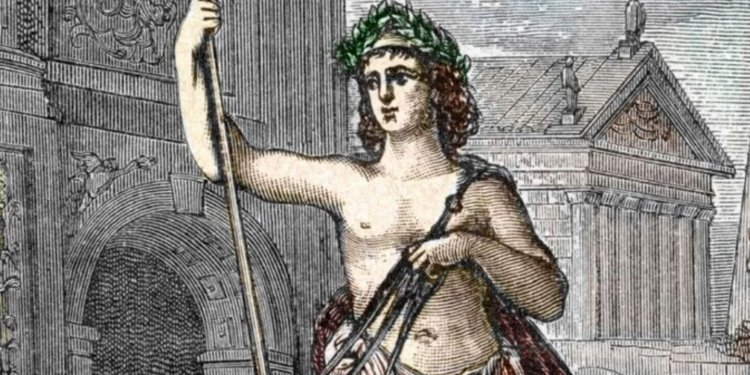I greatly enjoyed Steven Tucker’s very amusing piece about the Roman emperor Elagabalus (218-22) and the attempt by North Hertfordshire Museum to present this strange young man as a transgender and gay icon. On the face of this falls into the same nonsensical area as recent claims that Black Death London was a nightmare where people of colour were more likely to die thanks to the embedded racism of medieval England based on skull measurements (Inaya Folarin Iman has written an excellent piece on that in the Mail).
However, in Elagabalus’s case, I’m not so sure the story is so easily rubbished. I covered him in my book Domina: The Women Who Made Imperial Rome (Yale University Press, 2018). Elagabalus, actually born Varius Avitus Bassianus, was the grandson of Julia Maesa, sister-in-law of the emperor Septimius Severus (193-211). Maesa and her sister Domna were members of a Syrian aristocratic family from Emesa (Homs). After Severus died in York in 211 on campaign in Britain, the Roman Empire was inherited by his sons Caracalla and Geta. Caracalla killed Geta in their widowed mother’s arms in 212 and proceeded on a bloody and tyrannical reign that ended in his murder in 217. Bereft of status and power, as well as being afflicted by (probably) breast cancer, Domna committed suicide.
Caracalla had been murdered in a conspiracy led by Macrinus, praetorian prefect. Maesa was disgusted by this low-born man taking power and her own loss of status once her sister was dead too. A widow herself, she dreamed up an idea – she had two widowed daughters, each of whom had a young son. With no adult men in the way Maesa decided they could serve as an heir and a spare while the women did the ruling.
In 218 Maesa mounted her own conspiracy to get rid of Macrinus and present her grandson, still only 14 years old, as the new emperor. The young Avitus Bassianus was a fanatical priest in the cult of the sun god Heliogabalus (hence his nickname Elagabalus) which wasn’t a great asset. However, he was said to be fantastically good-looking, and bore a convenient resemblance to Caracalla. This made it easy to sell him to the army because Caracalla had paid the soldiers well. Macrinus was done away with, and the Syrian family set out for Rome.
Eventually in 219 the new emperor reached Rome, bringing with him the sacred stone (probably a meteorite) of his eponymous cult. As it entered the city the new court and its entourage must have looked and sounded like an avalanche in a seraglio. At least Elagabalus had the wit to travel to the Senate in his grandmother’s company, on the basis that she would enhance his own lack of authority.
He’d also sent a picture of himself in advance to let the Romans know what to expect. They were less shocked than they might have been and meekly accepted Elagabalus’s accession donative. A new temple was built and the theatrical cult rituals instigated, which involved vast numbers of animals sacrificed daily and Phoenician women dancing and playing instruments.
Overnight Rome started looking like the headquarters of a supercharged oriental despot from some outlandish myth. Appropriately enough the Romans nicknamed him ‘The Assyrian’. Elagabalus compounded his weirdness, according to Cassius Dio, by considering having his genitals amputated as part of his preference for effeminacy but decided in a moment of uncharacteristic restraint to desist. He contented himself instead with circumcision of himself and his cult associates as part of the rituals. Dio adds a number of other lugubrious details of Elagabalus’s antics, recounted with suitable prurient outrage, such as “he would go to the taverns by night, wearing a wig, and there ply the trade of a female huckster”. On other occasions he stood naked at the door of his palace rooms and solicit passers-by. Despite allegedly sleeping with numerous women he is supposed to have done everything possible to look like and go about as a woman. Eventually he took up with a charioteer called Hierocles and posed as Hierocles’s wife.
He had three disastrous marriages, including one to a Vestal Virgin, but otherwise indulged in a succession of homosexual and heterosexual liaisons.
That’s just one aspect of his peculiar behaviour reported by the senator Cassius Dio who was a contemporary. What’s more, Dio was probably in Rome. He certainly had the right contacts. Dio was no fool and at other points in his long history he is at pains to tell his readers when he had been an eyewitness to events of his own time. But he was influenced by subsequently being honoured by Elagabalus’s cousin and successor, Severus Alexander (222-35). Moreover, we don’t actually have Dio’s original account. What we have instead is an epitome – a summary – written up centuries later in abbreviated form and with some gaps.
Another contemporary, an imperial official called Herodian (but whose whereabouts in 218-22 cannot be determined), reported how Elagabalus, whose formal name as emperor was Marcus Aurelius Antoninus Pius, designed to give him a spurious lineage from famous emperors of the past) relished the most expensive clothing. This allegedly infuriated his grandmother Maesa, who could see her plans were going to end in tears. The young Emperor obsessively and extravagantly pursued his cult as well as driving a chariot. But “he used to go out with painted eyes and rouge on his cheeks, spoiling his natural good looks by using disgusting make-up”, said Herodian.
Maesa knew this would revolt the soldiers. She had already been on the receiving end of the young popinjay’s fury when she criticised him. She started lining up his cousin, Severus Alexander, to replace him. The soldiers (which means the Praetorian Guard in Rome) were disgusted “by the sight of the emperor with his face made-up more elaborately than a modest woman would have done, and effeminately dressed up with golden necklaces and soft clothes, dancing for everyone to see in this state” (Herodian again).
Around a century later, in a biography of Elagabalus, the tradition had endured. It reports that “he wished to wear also a jewelled diadem in order that his beauty might be increased and his face look more like a woman’s; and in his own house he did wear one”.
The upshot of it all is that in 222 Elagabalus and his hapless mother were murdered by the Praetorian Guard. His body, at least, was thrown into the Tiber. Severus Alexander was made emperor and lasted thirteen years until he and his mother Mamaea were murdered too. Lucky old Maesa had already pegged it from old age.
Now, it is undoubtedly true that in Roman tradition any hint that a man had become ‘effeminated’ was treated as evidence of unhealthy influence of women and male weakness. Mark Antony was seen as having become enslaved to Cleopatra after being softened up in advance by his previous wife, the dominant and fearsomely effective Fulvia. Cassius Dio, and before him the historian Tacitus a century earlier, had perceived the British tribal heroine Boudica (who led her revolt in AD 60) as possessing all the qualities of leadership and courage that Nero (whose army defeated her) lacked with all his perversions and corruption. Both Tacitus and Dio presented Nero and Boudica as diametric opposites and paradoxes, a literary motif which ancient historians liked to deploy.
So, on the face of it one must accept the possibility that Cassius Dio, Herodian and the fourth century biographers, had all set out to run Elagabalus down, precisely because it made others – in this case Severus Alexander – look better. But in this case we are dealing with two historians who lived at the time. That by no means guarantees the veracity of their accounts but it does mean that they were almost certainly reflecting the way Elagabalus was perceived at the time. And that’s important. Their versions of Elagabalus are so extreme that they go way beyond what would have been necessary to give him a bad press and big up Severus Alexander.
His coins, I’m afraid, are neither here nor there. They belong to a long-established tradition of Roman male imperial portraiture and imagery. The portraits of Elagabalus do indeed show his wispy adolescent beard, but they also resemble those of his cousins Caracalla and Geta and that would have been deliberate because it enhanced his spurious legitimacy. The coins were the visible manifestations of the state, an aspect of his reign controlled by his mother and grandmother. Not surprisingly, his sartorial habits and enthusiasm for cosmetics did not make it onto the issued designs just as Nero’s murder of his mother and Edward VII’s partying were omitted from theirs.
Occam’s Razor tells us that the simplest explanation for the stories about Elagabalus is the most likely to be true, or at least to have some truth in them. Dismissing all the ancient accounts as mere fiction, propaganda that had been contrived to paint Elagabalus as the antithesis of what an Emperor was supposed to be, leaves one having to invent an alternative version of events for which there is no evidence. And that’s a tricky solution.
Exaggeration and deliberate emphasis may well have played a part and there is no question that Dio and Herodian were themselves disgusted by Elagabalus’s reputation. However, my instinct in this case is that the stories about Elagabalus and his gender fluid behaviour must have had some foundation or else both Dio and Herodian would have been come up against contemporaries who knew they were not true. Their versions would have had no currency. The fact is that Elagabalus was murdered in short order and replaced by his cousin, which requires an explanation since it can hardly have been the desired outcome four years earlier.
However, where the truth ends and fantasy begins for Elagabalus is not now possible to determine. North Hertfordshire Museum’s decision to take Dio and Herodian at face value is probably as inappropriate as rejecting Dio and Herodian outright too. In that sense, the Elagabalus story is an allegory for all history and events in our own time. This wider question of the reliability of historical evidence and eyewitness testimony, and the effects of selective perception, especially in the light of the Covid Inquiry and other events of our era, is a source of fascination to me. I plan to look at it in a forthcoming piece, linking it also to how modelling and probability are utilised today to fabricate a version of the future, leading to a manipulation of the past in the light of how things turn out.












To join in with the discussion please make a donation to The Daily Sceptic.
Profanity and abuse will be removed and may lead to a permanent ban.